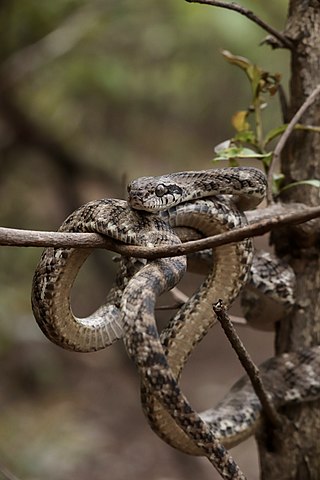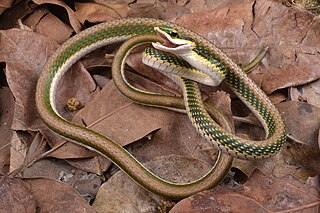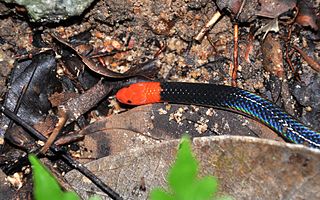
Pseudoboa neuwiedii, commonly known as the dark-headed red false boa or Neuwied's false boa, is a species of snake in the family Colubridae. The species is endemic to northern South America.

Oxyrhopus petolarius, commonly known as the forest flame snake, is a species of snake in the family Colubridae. The species is endemic to South America. There are three recognized subspecies.

Boiga dendrophila, commonly called the mangrove snake or the gold-ringed cat snake, is a species of rear-fanged venomous snake in the family Colubridae. The species is endemic to southeast Asia. It is one of the biggest cat snake species, averaging 6–7 feet in length. It is considered mildly venomous. Although moderate envenomations resulting in intense swelling have been reported, there has never been a confirmed fatality.

Boiga forsteni, also known commonly as Forsten's cat snake, is a species of mildly venomous rear-fanged snake in the family Colubridae. The species is endemic to South Asia.

Forsten's tortoise, also known commonly as the Sulawesi tortoise, is a species of tortoise in the family Testudinidae. The species is native to Sulawesi Island, Indonesia.

Dieurostus is a genus of snake in the family Homalopsidae. The genus Dieurostus is monotypic, containing only the species Dieurostus dussumieri, commonly known as Dussumier's water snake, or the Kerala mud snake. The species, which is mildly venomous and rear-fanged, is endemic to Kerala, in southwestern India. It was formerly thought to be found in Bangladesh, although its distribution there is now disputed.

The rainbow water snake is a species of mildly venomous, rear-fanged, colubrid snake, endemic to Asia.

Hydrophis peronii, commonly known as the horned sea snake, Peron's sea snake, and the spiny-headed seasnake, is a species of venomous snake in the subfamily Hydrophiinae of the family Elapidae. The species is endemic to the western tropical Pacific Ocean. It is the only sea snake with spines on the head. It is sometimes placed in its own genus Acalyptophis.

Leptophis mexicanus, commonly known as the Mexican parrot snake, is a species of medium-sized slender snake in the family Colubridae. The species is endemic to the Americas.

Ninia sebae, commonly known as the redback coffee snake or the red coffee snake, is a species of small terrestrial snake in the family Colubridae. The species is endemic to Mexico and Central America south to Costa Rica. Although it resembles some venomous coral snakes in color and size, it is not venomous and seldom bites humans.

Calamaria schlegeli is a species of snake in the family Colubridae. The species is known commonly as the red-headed reed snake, white-headed reed snake, and pink-headed reed snake. It is native to Southeast Asia, where it occurs in Brunei, Indonesia, Malaysia, and Singapore.

Calamaria gervaisii, commonly known as Gervais's worm snake, is a species of relatively small-sized burrowing or fossorial snake in the family Colubridae. This Snake feed on Earthworms and can grow maximum of 1FT or 30CM in length
Eltio Alegondas Forsten was a Dutch naturalist.
Rabdion is a genus of snakes of the family Colubridae.

Uromacer is a genus of snakes in the family Colubridae endemic to the island of Hispaniola.

Uromacer catesbyi, also known commonly as the blunt-headed Hispaniolan vine snake and Catesby's pointed snake, is a species of snake in the family Colubridae. The species is endemic to the island of Hispaniola.
Stegonotus is a genus of snakes in the family Colubridae. Species of the genus Stegonotus are native to Australia, Indonesia, and New Guinea.

Neelaps calonotos, also known commonly as the black-striped burrowing snake, the black-striped snake, and the western black-striped snake, is a species of venomous burrowing snake endemic to Australia. The specific epithet calonotos ("beautiful-backed") refers to the patterning on the upper surface of the body.
Scaphiodontophis annulatus, commonly known as the Guatemala neckband snake, is a species of snake in the family Colubridae. The species is native to southern Mexico, Central America, and Colombia. There are four recognized subspecies.

Pituophis deppei, commonly known as the Mexican bullsnake and the Mexican pine snake, is a species of nonvenomous colubrid snake endemic to Mexico. There are two recognized subspecies.















